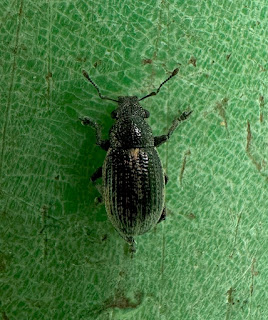Wednesday 14th August, Rudge Farm
Rudge Farm is situated on the Shropshire – Staffordshire border near to Chesterton. It is a large arable farm. On the western side of the farm an extensive area of heathland has been encouraged to regenerate and it is to this area that the group made its way.
I was unable to attend this gathering, but the group managed very well without me!
The only drawback is that I am unable to give a blow by blow account of the day.
In summary, unlike the Grand Old Duke of York, they started at the top of the hill, where they met. They did not march down but ambled at an extremely leisurely pace to the bottom then up the another hill to the heathland. The rest of the day was spent meandering about the heathland area in improving weather before retracing their steps to go home.
I understand it was quite hard work finding species but, to make me jealous, “there was a good range of bugs”.
And to rub it in I have been sent lots of photographs of what I missed.
Here they are.
The star of the show from an bug point of view, as we do not find this species very often, was a nymph of a Heather shieldbug.
 |
| Photograph: David Williams |
Other bugs found included a Spiked shieldbug.
 |
| Photograph: David Williams |
A Red-legged shieldbug or Forest bug whichever common name you prefer for Pentatoma rufipes.
 |
| Photograph: Nigel Cane-Honeysett |
A nymph of a Bronze shieldbug.
 |
| Photograph: John Martin |
A nymph of a Dock bug.
 |
| Photograph: Nigel Cane-Honeysett |
A striking red and black rhopalid bug, Corizus hyoscyami.
 |
| Photograph: David Williams |
An Ant damsel bug with some friends, a ground beetle and a springtail.
 |
| Photograph: Nigel Cane-Honeysett |
And a plant bug, Blepharidopterus angulatus, affectionately known as the Black-kneed capsid (as it has black knees).
 |
| Photograph: John Martin |
Having grouped the bugs (hemiptera) together why not do the same for the other photographs?
So I will.
Butterflies and Moths
A Small copper.
 |
| Photograph: John Martin |
A Square-spot rustic.
 |
| Photograph: John Martin |
A Straw dot.
 |
| Photograph: Nigel Cane-Honeysett |
Apotomis betuletana.
 |
| Photograph: John Martin |
A larva of a Buff-tip moth.
 |
| Photograph: John Martin |
A larva of a Vapourer moth.
 |
| Photograph: Nigel Cane-Honeysett |
Finally, a larva of a Mother Shipton moth.
 |
| Photograph: John Martin |
Bees and wasps
Galls of a gall wasp, Andricus grossulariae, on an oak.
 |
| Photograph: John Martin |
A bee, Andrena fuscipes.
 |
| Photograph: David Williams |
A nomada bee, Nomada rufipes.
 |
| Photograph: John Martin |
Nomada bees are cleptoparasites. The female nomada lays an egg in the nest cell of another bee. When the nomada egg hatches the larva proceeds to destroy the host bee’s egg or larva and then consumes the food that the host bee has provided for its larva. Nomada bees are often host specific and Nomada rufipes searches out the nests of three or four Andrena hosts including the species of bee in the earlier photograph, Andrena fuscipes.
Another bee, Colletes succinctus.
 |
| Photograph: David Williams |
A wasp, possibly Ammophila sabulosa.
 |
| Photograph: David Williams |
And finally for this group a sawfly, Gilpinia frutetorum, was recorded for the first time in Shropshire. Sorry, I do not have a photograph of it. However, more about this species can be found here: https://www.sawflies.org.uk/gilpinia-frutetorum/
Beetles
A 22-spot ladybird larva.
 |
| Photograph: Nigel Cane-Honeysett |
And the adult version.
 |
| Photograph: Nigel Cane-Honeysett |
A weevil, Hypera arator.
 |
| Photograph: John Martin |
Another weevil, Strophosoma sus.
 |
| Photograph: Nigel Cane-Honeysett |
And a ground beetle which may be Bembidion quadrimaculatus.
 |
| Photograph: John Martin |
Spiders and Harvestmen
Misumena vatia.
 |
| Photograph: Nigel Cane-Honeysett |
Anelosimus vittatus with its egg-sac.
 |
| Photograph: Nigel Cane-Honeysett |
And a harvestman, Nematoma bimaculatum.
 |
| Photograph: Nigel Cane-Honeysett |
Bush crickets
A Roesel’s bush cricket.
 |
| Photograph: David Williams |
Flies
And finally, a robberfly, Machimus atricapillus.
 |
| Photograph: Nigel Cane-Honeysett |
Other News
You may remember, if you are a regular reader of these ramblings, that a few weeks ago I included a photograph of a 1-day old Pine hawkmoth larva.
Here is the photograph.
%20TJ%202024-07-23.JPG) |
| Photograph: Tony Jacques |
Well, the larva has grown considerably and has now been returned to where the egg was found for it to pupate and mature in time into an adult moth. Whilst it was in temporary care a photographic record of its progress was kept.
Egg.
 |
| Photograph: David Williams |
12 days – 3rd instar.
17 days having just emerged as a 4th instar.
 |
| Photograph: David Williams |
26 days.
 |
| Photograph: David Williams |
Then it was returned.
Orthoptera and Dermatera
One of the group has become a published author.
 |
| Photograph: David Williams |
This excellent guide to the Grasshoppers, Groundhoppers, Crickets and Earwigs of Central and Northern Britain and Ireland by David Williams is a lavishly illustrated guide to these insects. Information about each species is provided under various headings on one page with a second page dedicated to photographs of the species showing life stages and variants with pointers to key identification features. See https://www.field-studies-council.org/2024/06/26/orthoptera-and-dermaptera-a-new-aidgap-guide/
It is available from FSC publications – https://www.field-studies-council.org/shop/publications/orthoptera-and-dermaptera/ and other booksellers.
My thanks to the owners for granting us permission to do what we enjoy doing and to the photographer for providing his excellent images for this report.







.JPG)











































